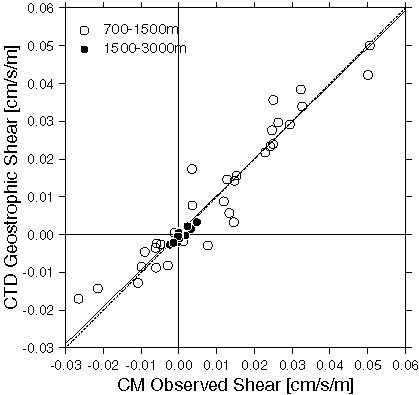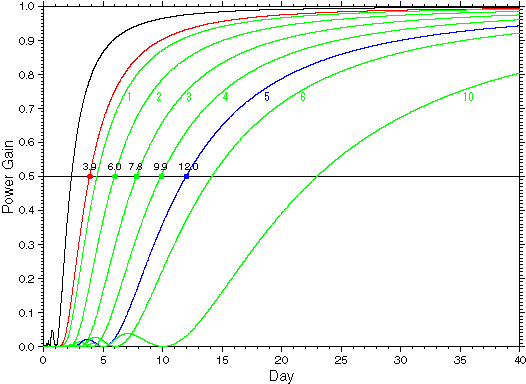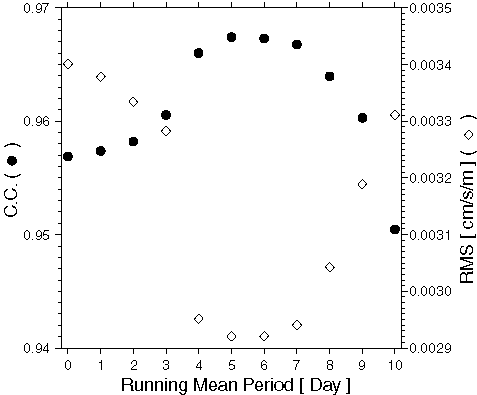Geostrophy
The Kurosho, along the ASUKA-line, is nearly in geostrophic balance.
The low-pass filtered velocity components normal to the observation line agree well with the
geostrophic velocities determined from hydrographic surveys (CTD).
The correlation coefficient between directly-measured velocity shear and
the geostrophic velocity shear is 0.96 and rms difference is 3.4x10-3 cm s-1m-1.
The highest correlation coefficient, 0.97, results when
the CM data are processed with 5-day running mean and a Godin
filter. In this case the rms difference is 2.9x10-3 cm s-1m-1.

The comparison between geostrophic shear calculated from CTD and the directly-measured velocity shear, processed with a Godin filter. The white (black) circles show the velocity shear between the CM at nominal depths of 700 m and 1500 m (1500 m and 3000 m). The solid line is the regression line. (The same figure of Godin and 5-day runnning mean.)

The power gain of filters used. The red line shows a Godin filter. The black is a 25 hour time running mean filter (TRM). The green lines are the Godin and TRM combined-filters (GTRM). The numbers from 1 to 10 are the days used in running mean of each GTRM. The blue line shows the combined-filter, 5-day GTRM, which results in the highest correlation in the geostrophy comparison. Its half power gain period is 12.0 days.

Variations of correlation coefficients and rms differences between the geostrophic shear and the measured velocity shear, due to different periods used in GTRM filters from 0 to 10 days.
DISCUSSION
The geostrophic shear estimated from CTD data describes the instantaneous velocity shear averaged horizontally between the two hydrographic stations. The velocity shear measured by CM describes the velocity shear locally at the CM mooring station, continuously in time.
The high-frequency ageostrophic signal in the CM data can be removed by the low-pass filters. This is the reason why the correlation improves with increasing GTRM period up to 5 days (half-power gain at 12.0 days). Significant change exists between 2 and 4 days of GTRM period.
If the Kuroshio south of Shikoku were a stable geostrophic current, the correlation coefficient
should continue to be higher for longer GTRM period, but this is not the case. The Kuroshio migrates horizontally north and south.
In the comparison for longer period average, the representativeness of the instantaneous estimate of
geostrophic shear from CTD data becomes lower. This is the reason why the
correlation becomes worse with increasing GTRM period beyond 5 days. The
averaging period which results in the best comparison is probably
determined by the characteristic time scale of the Kuroshio variability.
The high-frequency ageostrophic signal in the CM data can be removed by the low-pass filters. This is the reason why the correlation improves with increasing GTRM period up to 5 days (half-power gain at 12.0 days). Significant change exists between 2 and 4 days of GTRM period.
If the Kuroshio south of Shikoku were a stable geostrophic current, the correlation coefficient should continue to be higher for longer GTRM period, but this is not the case. The Kuroshio migrates horizontally north and south.
In the comparison for longer period average, the representativeness of the instantaneous estimate of geostrophic shear from CTD data becomes lower. This is the reason why the correlation becomes worse with increasing GTRM period beyond 5 days. The averaging period which results in the best comparison is probably determined by the characteristic time scale of the Kuroshio variability.





